In March 2022, Wi-Fi routers supporting the 5.9GHz portion of the 5GHz frequency officially became available. Since then, this “final frontier” of the spectrum, known in the US as the UNII-4 group, has proved to be of limited use.
This post will explain, in simple terms, UNII-4, the reason behind its significance—namely, the existence of Dynamic Frequency Selection (DFS)—and answer the question of why the latest Wi-Fi 7 hardware doesn’t support it.
Dong’s note: I first published this post on March 17, 2022, and updated it on July 20, 2025, to add up-to-date information.
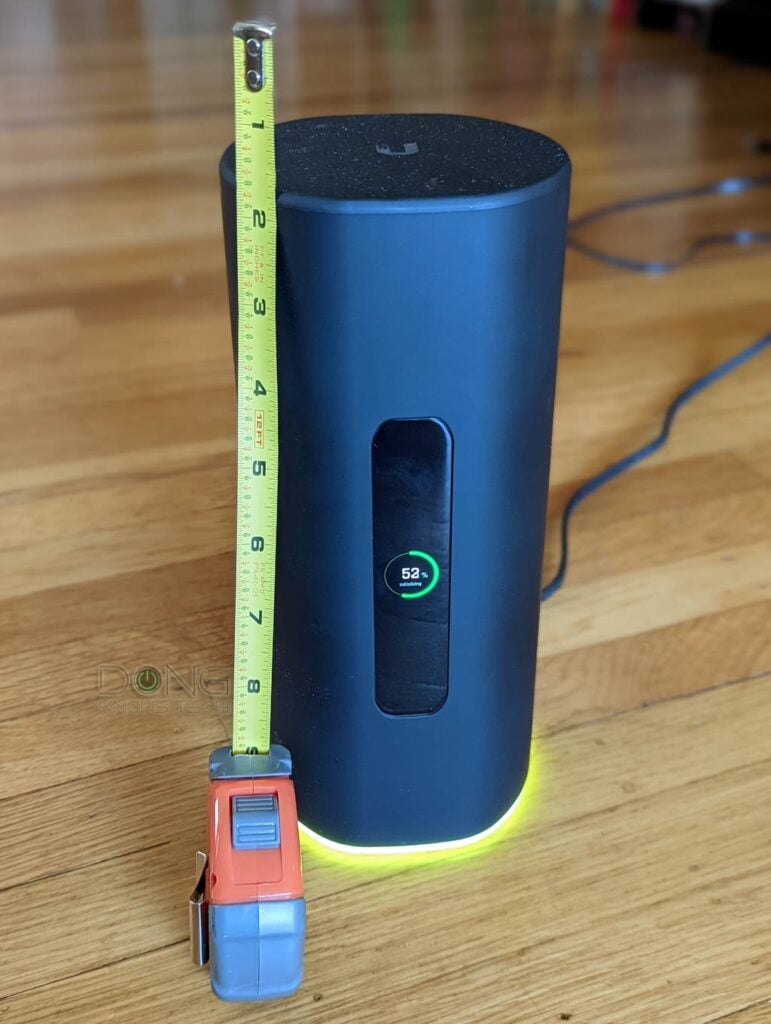

What is the 5.9GHz (Wi-Fi 6) band?
Wi-Fi first started in 1999 with the 2.4GHz frequency band, and ten years later, moved to the dual-band concept as 5GHz became available for networking.
Tip
Wi-Fi airspace is regulated and varies from one region to another. Information on this website is generally based on US regulations and applicable to the United States.
The use of the UNII-4 portion, or even its definition, might not be the same or available in other parts of the world, but the general concept of Wi-Fi is applicable worldwide.
As you might have noted, 2.4 is a portion between 2.3 and 2.5, whereas 5 is a whole number. In other words, it appears that the entire 5GHz frequency is available for Wi-Fi use.
Is it, though?
The initial three UNII groups of the 5GHz frequency
In reality, things are much more complicated. From the get-go, Wi-Fi has never had the entire 5GHz band for itself—far from it—nor will it ever.
Like all frequency bands, the 5GHz spectrum is divided into smaller portions from 5.1GHz to 5.9GHz. You can visualize this by putting a measuring tape on the floor. Before it reaches the 6-meter mark, the surface must encompass the entire 5-meter section, which consists of many smaller sections, each measuring millimeters.
The sub-portions of a Wi-Fi band are measured in MHz. (1GHz = 1000MHz). For better management, in the US, they are divided into four groups referred to as Unlicensed National Information Infrastructure (UNII).
The following is the ballpark breakdown of these groups:
- UNII-1 ranges from 5170MHz to 5250MHz
- UNII-2: 5250MHz to 5330MHz
- UNII-2e (extended): 5490MHz to 5730MHz
- UNII-3: 5735MHz to 5835MHz
- UNII-4: 5850MHz to 5925MHz
- There are gaps in the spectrum between the groups above. Those are areas of the spectrum permanently dedicated to non-Wi-Fi applications. For example, the gap between 5330MHz and 5490MHz is exclusively used for Doppler RADAR.
- Before 2022, UNII-4 was not available for Wi-Fi use.
To understand the significance of these groups, it is essential to comprehend how Wi-Fi operates in terms of bandwidth.
Wi-Fi bandwidth
A Wi-Fi connection typically utilizes a contiguous portion of the frequency band, called a channel. The minimum width of a channel is 20MHz, and the wider the channel being used, the more bandwidth the connection has—it’s faster.
Equipment can combine adjacent 20MHz channels to create a wider channel and, therefore, the bandwidth. So, two adjacent 20MHz channels combine to form a 40MHz channel, and two adjacent 40MHz channels combine to form an 80MHz channel, and so on.
Tip
Back to the measuring tape analogy, you can combine multiple millimeters into a centimeter and multiple centimeters into a decimeter. Essentially, it’s as basic as putting adjacent surface sections together to create a large, continuous area.
The novelty of Wi-Fi 6 is that it supports 5GHz channels as wide as 160MHz, making it a significantly faster standard compared to Wi-Fi 5, of which the channel width maxes out at 80MHz.
As you might imagine, the wider the channel, the more space it occupies on the spectrum. Wi-Fi 6’s 160MHz channels are so large that the entire spectrum has enough space to form two such channels in theory.
In practice, things are not as simple as combining as many channels as you wish, as not all of them are available at all times due to the use of Dynamic Frequency Selection (or DFS).
Dynamic Frequency Selection and the 5GHz band’s lack of contiguous 160MHz width
Applicable only to the 5GHz frequency, DFS channels refer to the 20MHz portions that share the airspace with radar, which have the right-of-way.
Typically, these DFS channels function in the same manner as any other Wi-Fi channel. However, when radar signals are present, which is often the case for those living within tens of miles of an airport or weather station, the router will shift its signals to the next unoccupied DFS channel or reduce the channel’s width to avoid the DFS ones.
During this channel-switching process, your device might briefly get disconnected.
Here’s the real issue: of the entire original 5GHz frequency, the UNII-1 (5170MHz to 5250MHz) and UNII-3 (5735MHz to 5835MHz) portions don’t include DFS channels. However, these portions are only 80MHz wide each and are not within a contiguous airspace of each other. For that reason, if you want to form any 160MHz channel, you’ll need to use a few DFS channels within it, as shown below.
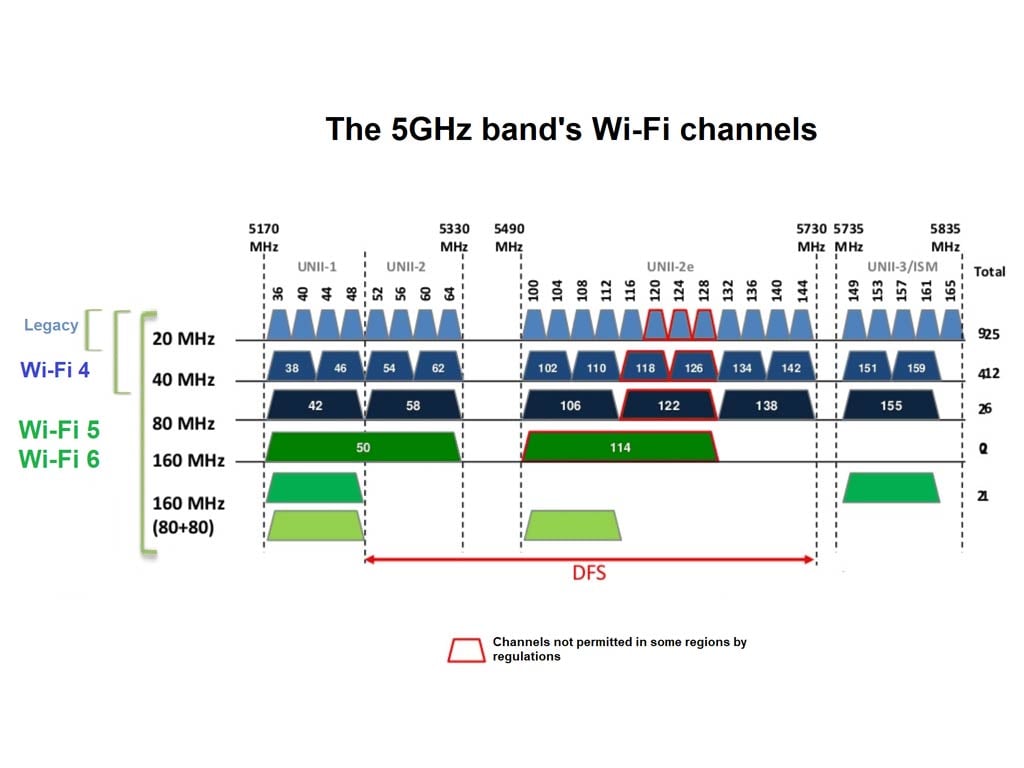

As a result, from the early days of Wi-Fi 6 until early 2022, the use of 160MHz channels was never a certainty. In fact, many Wi-Fi 6 routers opt to use the 80MHz channel width instead to avoid DFS entirely.
And that brings us to the final UNII-4 group, which includes the 5.9GHz portion.
The late arrival of UNII-4
For decades, this portion of the 5GHz band has been controversial because it was reserved for the automotive industry, which ultimately never utilized it—it was a long story.
Wi-Fi advocates fought long and hard for this final airspace of the 5GHz band, and finally, in late 2020, the FCC approved it for Wi-Fi use. It was then made available to hardware vendors in late 2021. With that, Wi-Fi gets the frequency’s tail with three more 20MHz channels, including 169, 173, and 177.
Combining those with existing channels forms a 160MHz contiguous air space, enough to make a third 160MHz channel. The table above shows how the addition of the UNII-4 group completes the 5GHz band for Wi-Fi use. (Again, the borders dividing these groups are flexible.)
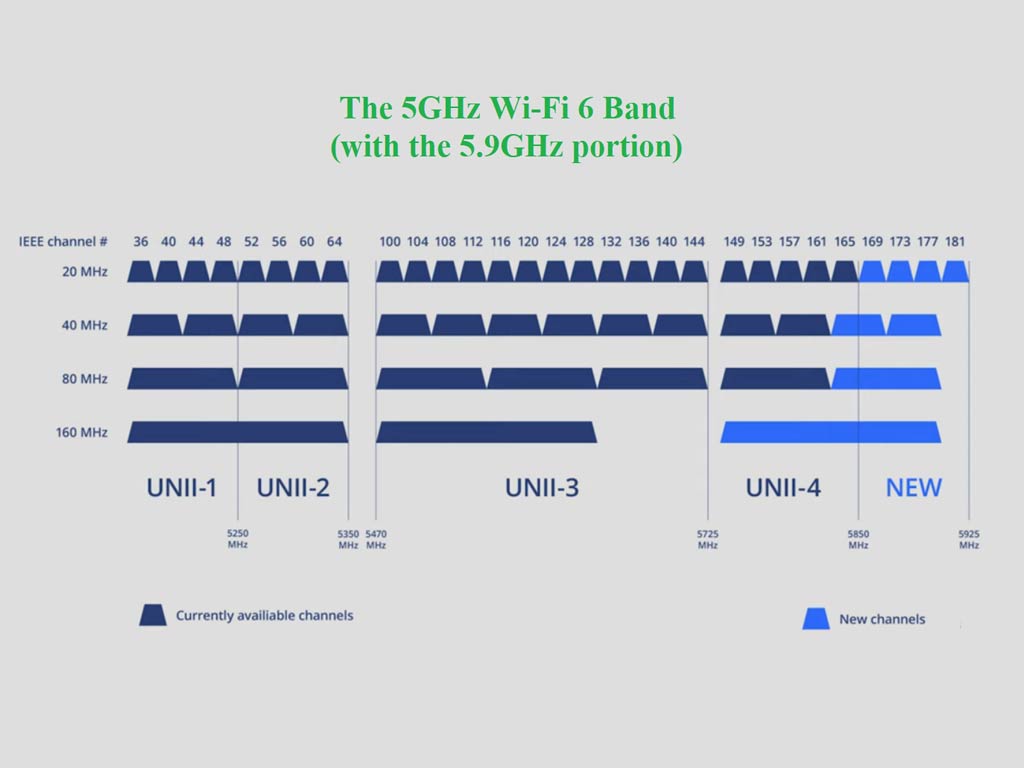

Most importantly, this new 160MHz channel is the only one that does not use DFS. In other words, it’s the only “clean” high-bandwidth channel that can deliver Wi-Fi 6’s top speed and reliability, even when used near RADAR stations.
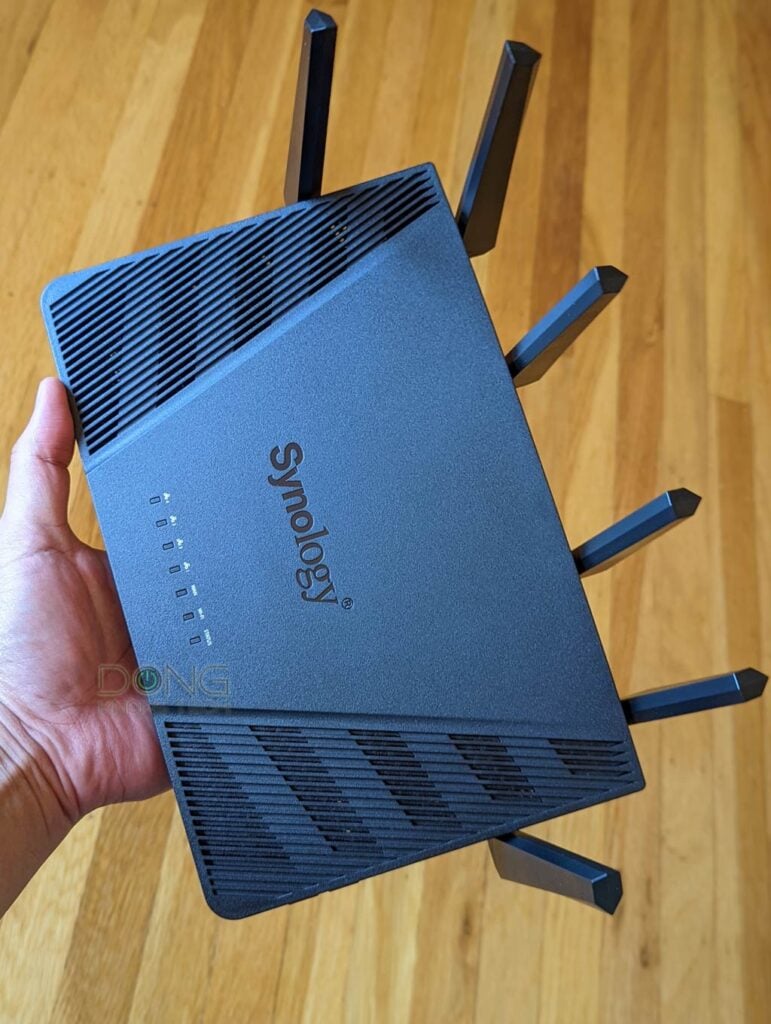

That said, the 5.9GHz band enables an exciting potential: Fast Wi-Fi 6 speeds (up to 4800Mbps in the current top 4×4 specs) and long range.
However, for this portion of the frequency to have a real-world impact, it needs to be supported by the hardware, and that has become a relatively subdued reality for the 5.9GHz portion.
5.9GHz band: Limited but significant real-world applications
Like all Wi-Fi connections, the use of the 5.9GHz portion, by itself or as part of a 160MHz channel, requires support from both ends: the broadcaster (router or access points) and the receiver (Wi-Fi client).
Let’s start with the former.
Sparse support on the broadcasting side
While most existing routers can have support for this portion of the band turned on via firmware updates, most vendors opted not to do so due to the expensive re-certification process. By mid-2022, the Asus ZenWiFi XT8 was the only router that had this treatment, starting with firmware version 3.0.0.4.386_49873.


Since then, I’ve reviewed over half a dozen new routers with UNII-4-enabled capabilities, and their number hasn’t grown significantly in the past couple of years.
That said, it’s safe to say the adoption of the 5.9GHz portion hasn’t been strong. And the reason is simple: there’s no support on the client side.
Non-existent support by end-devices
Indeed, so far, there are no Wi-Fi clients, such as computers or smartphones, that feature 5.9GHz Wi-Fi. As a result, when a router uses this portion of the band, no client can connect to it, making UNII-4 practically useless in a traditional Wi-Fi network.


Regulations are generally less restrictive on Wi-Fi clients—when we travel with our mobile devices, the receiver should work with all Wi-Fi broadcasters worldwide. However, it’s ultimately the vendors who decide whether the hardware can connect via this portion. And so far, they have decided to opt out of UNII-4 entirely on the receiving end. Well almost.
Wireless mesh backhauling gets a significant boost
Technically, you can have a UNII-4 connection when using a supported mesh unit as the receiver. Specifically, when you connect a wired client to the satellite unit of the ZenWifi XT8, the client establishes a connection to the primary router using a 5.9GHz connection.
That’s because a UNII-4-enabled mesh system can use this portion of the frequency as the backhaul link. In this case, you receive dedicated backhaul via a clean 160MHz channel, which guarantees the best possible performance in both data rates and reliability. And that’s generally the case with tri-band Wi-Fi 6 mesh systems that support 5.9GHz, as mentioned on the list above.
Backhaul vs. fronthaul
When you use multiple Wi-Fi broadcasters—in a mesh Wi-Fi system or a combo of a router and an extender—there are two types of connections: fronthaul and backhaul.
Fronthaul is the Wi-Fi signals broadcast outward for clients or the local area network (LAN) ports for wired devices. It’s what we generally expect from a Wi-Fi broadcaster.
Backhaul (a.k.a backbone), on the other hand, is the link between one satellite Wi-Fi broadcaster and another, which can be the network’s primary router, a switch, or another satellite unit.
This link works behind the scenes to keep the hardware units together as a system. It also determines the ceiling bandwidth (and speed) of all devices connected to the particular satellite Wi-Fi broadcaster.
When a Wi-Fi band handles backhaul and fronthaul simultaneously, only half its bandwidth is available to either end. When a Wi-Fi band functions solely for backhauling, often available traditional Tri-band hardware, it’s called the dedicated backhaul.
Generally, for the best performance and reliability, network cables are recommended for backhauling—wired backhauling, which is an advantage of mesh Wi-Fi hardware with network ports. In this case, a satellite broadcaster can use its entire Wi-Fi bandwidth for front-hauling.
5.9GHz Wi-Fi 6: Practically useless in dual-band broadcasters
It’s worth noting that, due to the lack of support from the receiving end mentioned above, generally a UNII-4-enabled broadcaster has this portion turned off by default. The reason is that a band can only work on one channel at a time, and utilizing the 5.9GHz portion means the 5GHz band will not support non-UNII-4 clients, which is the case for all existing clients.
As a result, UNII-4 has only made sense in traditional tri-band broadcasters, where it’s safe to use this portion on the upper-channel band for the wireless backhaul link, leaving the lower-channel band for clients.
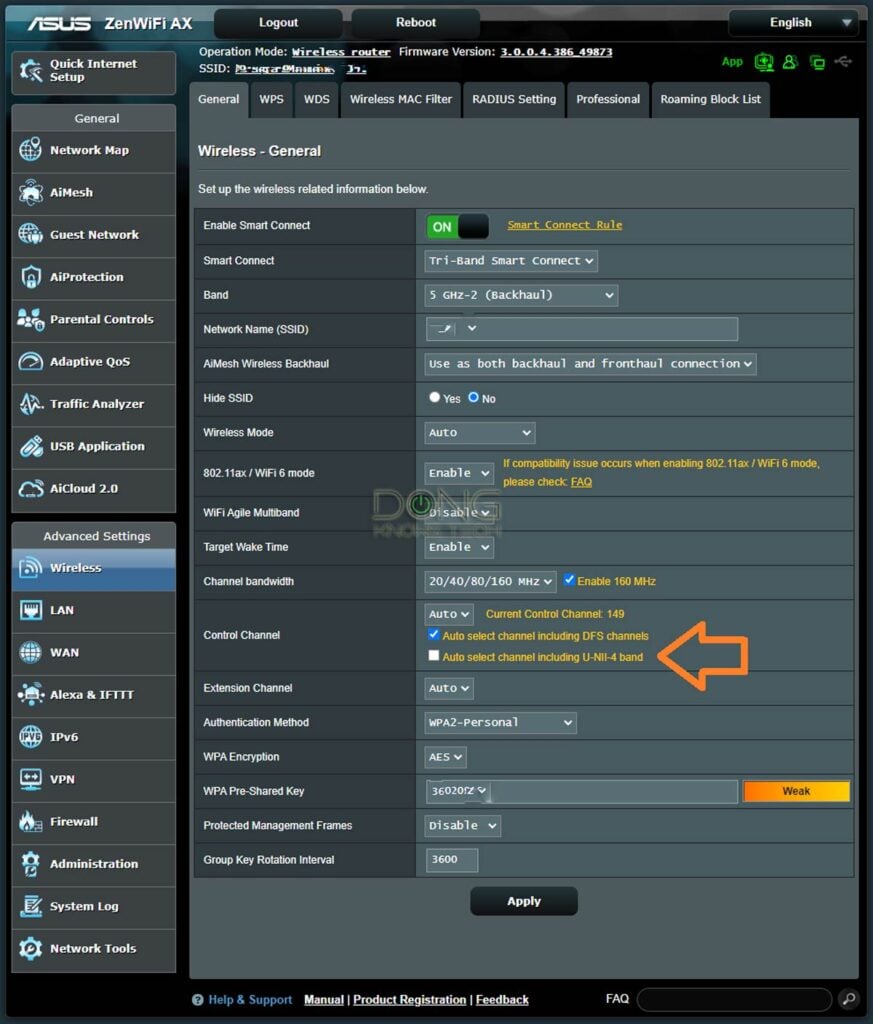

For the same reason, it’s essential to note that on broadcasters that have only one 5GHz band, such as a dual-band Wi-Fi 6 router like the Synology WRX560, there’s simply no reason to enable the UNII-4 portion, as it has no supported clients.
Wi-Fi 7 and UNII-4: The 5.9GHz band is simply non-applicable
If you’re wondering if Wi-Fi 7 hardware supports UNII-4, the answer is that there’s simply no use for this portion in the latest Wi-Fi hardware.
For one, the strength of Wi-Fi 7 is in the 6GHz band. The new Wi-Fi standard also features a new feature called Multi-Link Operation (MLO), which can combine multiple bands into a bonded link, making the use of the 5.9GHz portion as the backhaul largely insignificant. Finally, the lack of support on the client side—Wi-Fi 7 devices don’t support the 5.9GHz portion—means it’s pointless for the broadcasters to support it.
That said, Wi-Fi 7 broadcasters generally don’t support UNII-4. They simply have no reason to.
The takeaway
The availability of the 5.9GHz band for Wi-Fi use was a natural progression of the 5GHz frequency.
Unfortunately, the availability of this portion in early 2022 arrived too late compared to the availability of Wi-Fi 6 itself, which happened in early 2019. As a result, by the time it was released, the ship carrying the Wi-Fi chips intended for clients had sailed—so far, there has been no end-device supporting this band. As a result, the adoption of UNII-4 proved to be fragmented and was only meaningfully applicable to the backhauling of tri-band Wi-Fi 6 mesh systems.
Nowadays, with the availability of Wi-Fi 7, which offers more options to enhance Wi-Fi performance, such as MLO and AFC, the use of 5.9GHz Wi-Fi 6 has become increasingly less significant. However, if you already have a 5.9GHz-endable mesh system in a wireless setup, keep using it. It represents the best of Wi-Fi 6, which remains relevant today and for the foreseeable future.
